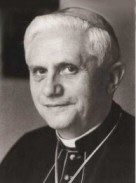
Cardinal Ratzinger
| Bible Research > English Versions > Roman Catholic > Inclusive Language Conflict |
The Roman Catholic Church has had its share of battles over inclusive language translations in the past few years, but unlike in the Protestant churches, where the focus of the conflict has been upon new Bible versions, Roman Catholics have for the most part focused on the Lectionary for the Mass. A lectionary is an anthology of biblical lections, passages which are to be read in the worship service according to a fixed schedule for the church year. Because the Roman Catholic hierarchy is especially careful about what is read in the worship service, it may disapprove of a translation for the lectionary which it has otherwise approved for private reading and other uses. A Bible version may thus have the official approval of a bishop (called the imprimatur) without being approved for reading in the worship service. One Roman Catholic liturgical newsletter explains:
The process for approving a lectionary begins with the submission of a Bible translation for the bishops' approval; then the texts are selected for the Lectionary using that version of the Bible. The proposed new Lectionary must be approved both by the bishops' conference and the Holy See. In the US, the Lectionary generally used is based on the New American Bible. Other translations approved for liturgical use are the Jerusalem Bible and the Revised Standard Version - Catholic Edition. All of these approved versions, however, have been recently retranslated to incorporate feminist language. 1
The recent lectionary controversy began when the American bishops approved a revision of the New American Bible which featured the kind of inclusive language desired by feminists in the Roman Catholic Church. Actually, the bishops themselves practically mandated this revision of the NAB when they adopted in 1990 a set of principles called "Criteria for the Evaluation of Inclusive Language Translations of Scriptural Texts Proposed for Liturgical Use." These criteria were used by the editors of the NAB revision committee so as to create the "inclusive" text that the bishops wanted for the lectionary. But when the new lectionary was submitted to Rome for approval in 1992, it was rejected, despite a concerted effort on the part of the American bishops to gain approval for it.

In Rome the opposition to the new American lectionary was led by Cardinal Joseph Ratzinger, an prominent conservative from Germany who since 1981 had served as Prefect of the Vatican's Congegation for the Doctrine of the Faith, the agency responsible for taking action against heretical tendencies in the Church. Cardinal Ratzinger perceived that the "inclusive" language of the proposed lectionary involved an erosion of doctrinally significant language in the biblical text, and that (despite the claims of liberal American bishops that such language was necessary on "pastoral" grounds) its main purpose was to give aid and encouragement to the increasingly heretical feminist element in the Church. Nevertheless, even after it became clear that the Vatican was resolutely opposed to the whole concept of "inclusive language" in the Mass, American bishops did not withdraw the proposed lectionary from consideration, and held out for a compromise.
The Vatican was not inclined to compromise on the issue. In 1995 the Congegation for the Doctrine of the Faith drew up a set of guidelines called Norms for the Translation of Biblical Texts for Use in the Liturgy,2 which Cardinal Ratzinger presented to American bishops in confidential consultations at Rome. These "norms" amounted to a point-by-point rejection of the "inclusive language" guidelines adopted by the American bishops in 1990. The final resolution of the lectionary conflict was brought about in a series of meetings held in the Spring of 1997, as reported in the American National Catholic Reporter:
After years of back-and-forth negotiations, a special 11-member working group was convened in Rome from Feb. 24 to March 8, 1997, to hammer out the final text of the lectionary. Four American bishops, two officials of the U.S. bishops' conference, four Vatican officials and one outside adviser performed revisions that were eventually adopted by the U.S. bishops and approved in Rome. 3
In June of 1997 the revised lectionary was sent, along with the Vatican "norms" which had guided the revision, to the American bishops for their approval. The revisions and the "norms" were the subject of indignant protests and much debate at their 1997 annual meeting (held June 19-21), but the lectionary as revised in Rome was approved by the American bishops, who recognized that there was no realistic hope of an "inclusive language" lectionary being approved in Rome at this time.
Any remaining expectations that the Vatican would eventually approve the use of artificial "inclusive language" were finally put to rest when in March 2001 the Vatican issued the comprehensive Instruction on translation known as Liturgiam Authenticam, "the Authentic Liturgy." This document elaborated upon the 1997 guidelines, and is broadly opposed to paraphrastic renderings of all kinds. In April of 2005 Cardinal Ratzinger became Pope Benedict XVI.
1. Helen Hull Hitchcock, "Cardinals Meet Vatican Officials on Mass Texts," Adoremus Bulletin, February 1997.
2. These norms were first published by the National Catholic Reporter on July 4th 1997.
3. John L. Allen Jr., "Vox Clara commission to monitor English translation," The National Catholic Reporter, 7 April 2002.
| Bible Research > English Versions > Roman Catholic > Inclusive Language Conflict |